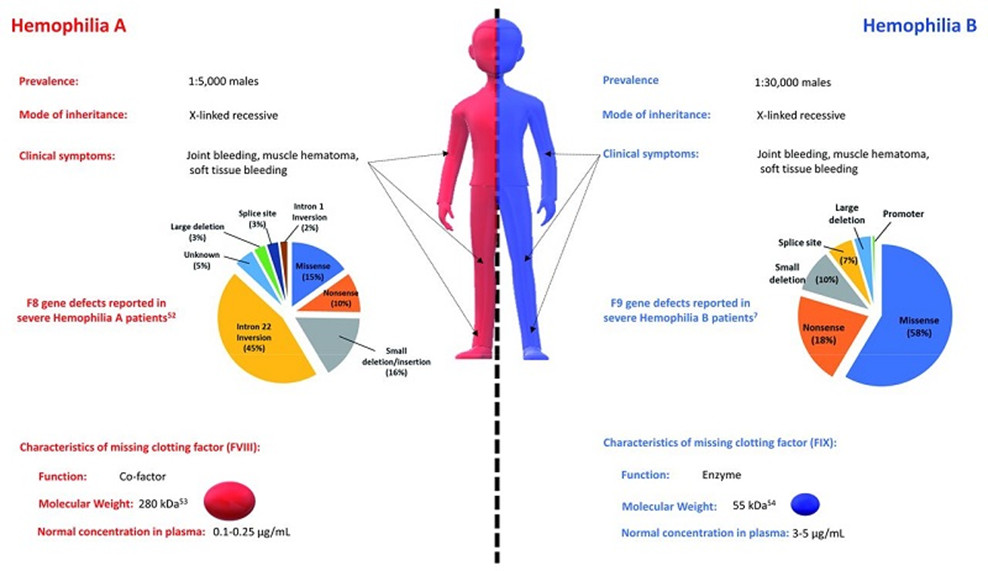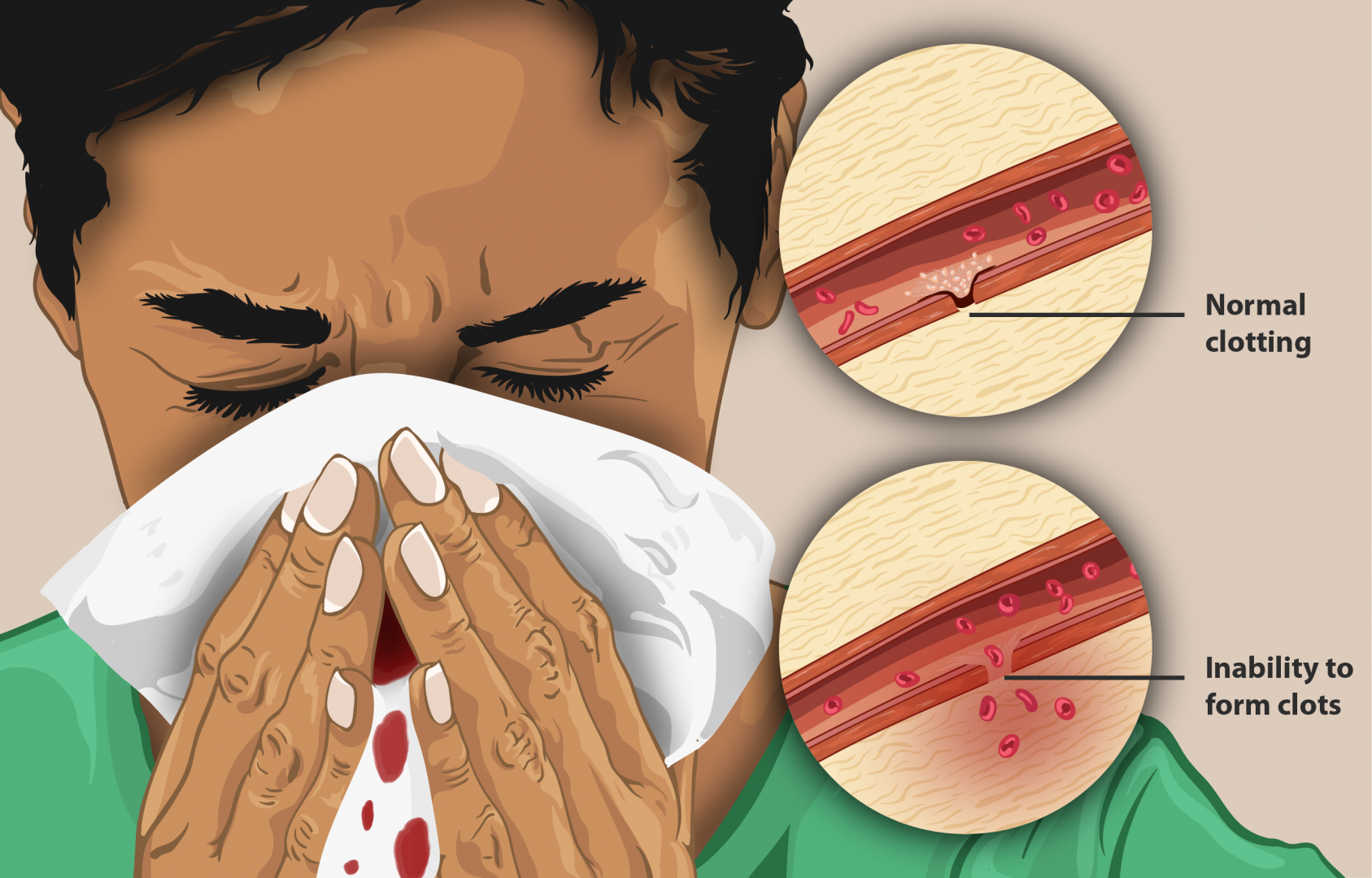
HEMOPHILIA
WHAT IS HEMOPHILIA?
Hemophilia is an X-linked hereditary bleeding disorder caused by a decrease in factor VIII (hemophilia A) or factor IX (Hemophilia B) leading to thromboplastin production, which slows blood clotting.
In patients with hemophilia, the clotting factor is missing, or the factor levels are low compared to normal people, which makes it difficult for blood clots to form.
According to statistics:
| Hemophilia occurs in about 1 out of every 5,000 male births |
| About 30,000 to 33,000 men in the US are living with hemophilia |
Mingot-Castellano ME, Núñez R, Rodríguez-Martorell FJ. Hemofilia adquirida: epidemiología, clínica, diagnóstico y tratamiento. Medicina Clínica 2017;148(7): 314-322


CAUSES OF HEMOPHILIA
- Most cases of hemophilia are hereditary, which means that the disease is passed on from the parents' genes and the patient was born with hemophilia and not from someone else.
- However, there is 1/3 of patients with no family history. These cases are thought to be caused by a spontaneous mutation in the patient's own gene.
Classification of hemophilia:
| Hemophilia A: also known as factor VIII deficiency, is the most common type of hemophilia. It occurs in about 80% of people with hemophilia. | Hemophilia B: less common, with only 20% of patients presenting with hemophilia B |
| The F8 genes are large, occupying about 0.1% of the X chromosome, consisting of 26 exons 186,000bp in size and encoding 2332 amino acids. The gene that regulates FVIII synthesis is located at position Xq28 on the X chromosome. - Common mutations (F8): Inversion of Intron 22 (usually inversion, also known as IVS-22). Intron 1 inversion (usually inversion, also known as IVS-1). Other variants include point mutations (including nonsense mutations) and small fragment deletions. Gene disruption variants. Point mutations cause amino acid changes. + Combined factor VIII and V deficiency (LMAN1 and MCFD2 genes). | Gene F9 - located at the end of the long arm of the X chromosome, contains 8 exons and 7 introns. F9 is the largest gene in the family of vitamin K-dependent clotting factors; it contains highly conserved features (exon number, splice types) that are highly conserved in homologous vitamin K-dependent proteins. - F9 Cambridge and F9 Oxford - Defects in post-translational processing that prevent cleavage of the 18-amino-acid propeptide of factor IX. - F9 Chapel Hill - Impaired activation of zymogen due to interference with one of the factor IX cleavage sites - F9 Vancouver - Interference with the catalytic activity of factor IX with factor X by a point mutation that changes isoleucine to threonine at amino acid position 397, affecting the hydrogen bonding between threonine 397 and the oxygen carbonyl of tryptophan 385 - Hemophilia Bm - A dysfunctional protein that causes prolongation of prothrombin time (PT). Complete gene deletion has been described but is rare. |

The severity of hemophilia depends on the amount of clotting factors present in the blood. Infected family members have similar levels of clotting factors. Normally, factor VIII and factor IX range from 30 to 200%.
- Severe hemophilia:
Factor VIII or IX is less than 1%. Bleeding in muscles, joints, or other organs occurs spontaneously or after minor trauma.
- Moderate hemophilia:
Factor VIII or IX concentrations range from 1% to 5%. Bleeding after moderate trauma or surgery, tooth extraction.
- Mild hemophilia:
Factor VIII or factor IX from more than 5% – < 30%. Bleeding is often associated with major trauma, surgery, or tooth extraction. Patients are often diagnosed late, associated with trauma or dissection.
SYMPTOMS OF HEMOPHILIA BLOOD DISEASE
- Bleeding into the joints: may cause swelling and pain or tension in the joints; Usually affects the knees, elbows, and ankles.
- Bleeding into the skin (bruising) or causing a buildup of blood in the area (hematoma).
- Bleeding from the mouth and gums, and bleeding that is difficult to stop with tooth loss.
- Bleeding after circumcision, bleeding after injection.
- Blood in urine or stools.
- Frequent bleeding and difficulty clotting

Although clinical symptoms of hemophilia and family history may suggest hemophilia, a definitive diagnosis must be based on blood tests.
Hemophilia is currently not completely cured, but with treatment to supplement the missing clotting factor, people can live healthy lives.
TESTING FOR HEMOPHILIA IN GENTIS
- Sample: 2-3 ml of whole blood collected in an EDTA tube
- Technology used: Long distance PCR and Whole exon sequencing of F8 and F9 . genes
- Time to return results: 6 weeks
Preimplantation embryo genetic analysis (PGT) is the best option when the parents have some genetic changes and want to avoid passing them on to their children in the future.
This involves genetic analysis of embryos during IVF/ICSI treatment, to transfer to a woman's uterus only healthy embryos with no disease, in the case of This is hemophilia.
GENTIS offers the PGT-M Preimplantation Embryo Genetic Analysis test for families with hemophilia with a good chance of having a healthy baby.
Please fill in the information below to receive our supports and consultations!







